Soybeans—The Best Food Plot Choice, Most of the Time
I am a firm believer, or more accurate, I have seen overwhelming evidence to support, that deer food plot attractiveness is a relative thing. Over the years I have planted most kinds of food plots. I have tried almost every combination of ideas out there to attract, hold, and keep deer coming onto my hunting grounds in ways to make it easier to hunt them. And in almost every case, a well thought out stand of soybeans has outperformed any other food source I have ever hunted. When I say outperformed, that is also a relative thing. But as a hunter, my number one goal with planting food plots is to ultimately have them lead to me killing deer (or in most cases good bucks). I have also learned that all the hype centered on food plots for hunting is big money with every manufacturer claiming to have an edge on the rest, most paying big dollars to advertise and promote their seeds through TV spots and add campaigns. But it all comes back to attractiveness; how a food plot works at bringing in the deer will determine how they help us in hunting.
Soybeans are the ultimate food plot.
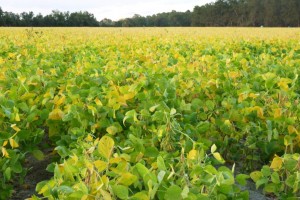
The only time soybeans are not a preferred food source is for a brief period when the green leaves are no longer attractive and turn yellow. This yellowing and ripening stage lasts only a few weeks when the deer will once again feed on the soybean pod and seed.
From the time a soybean plant pops out of the ground in early spring until the beans are consumed in late fall or winter, there are very few times that a standing plot of soybeans will not attract and hold the local deer herd. When they first emerge, deer will browse the young sprouts and consume the high protein leaves and stems like candy. This will last from April or May until the plant starts to yellow in late summer or early fall. Then, for a brief time as they ripen and yellow, deer will avoid the bean fields only to return a few weeks later to once again pound the pods filled with the ripened beans. The field stays a preferred food source until every last pod is consumed…this can last well into winter. What other food plot has that kind of high value nutrition for that long of a time frame?
No other food plot can draw deer like a stand of beans.
Attractiveness is a relative thing! What can be a very attractive and preferred food source in one area can be a non-factor in another. During my days of hunting in the big timber of northern Wisconsin I learned this first hand. While scouting in early fall it was common to find deer feeding in clear cuts, grassy meadows, oak ridges, or on red dogwood…but each year as hunter numbers increased in preparation for the gun deer season, so did the preferred food source as tons and tons of shelled corn was dumped on the ground at bait stations. The once active meadows and clear cuts didn’t see much action any more.
On the farm I hunted in western Wisconsin the results were similar. Each year, during the summer and early fall time periods, deer would be seen feeding mostly on alfalfa and soybean fields. But after the fall harvest and once the alfalfa saw some good frosts, the preferred food source was once again corn piles. Even during a year when baiting was banned, no food plot could “compete” with the corn piles. (Yes, even though baiting was banned most hunters who had baited in the past kept doing it.) Every deer we harvested had shelled corn in their paunch even though corn had been off the fields for weeks. During these years we planted brassicas, rye, clovers, alfalfas, milo, seed blends, rape, oats, you name it and the results were always the same….our food plots drew in some deer some of the time but just couldn’t compete on a regular and predictable basis like neighboring corn piles. I’m not knocking baiting—the point here is that our food plot attractiveness was always a relative thing. What was available was the determining factor of their drawing power. I’ve even seen this phenomenon in southern Iowa where baiting is illegal as land owners “feed” deer (feeding is legal) on parts of their farm and hunt other parts. Countless examples exist of other scenarios where oats, clovers, brassicas, and other plots are attractive in one place but don’t get but a nibble two miles down the road. The best most attractive food source in one area might be just green grass, while in another area a clover plot, while in another area the most attractive might very well be a corn pile. It is therefore in our best interests to make sure we have the most attractive food source on our hunting grounds. There’s no secret food plot blend that changes all this, no high priced hyped up personality sponsored seed that has a corner on a deer’s appetite…with maybe one exception!
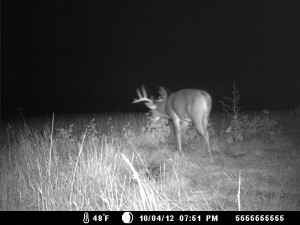
Deer will feed heavily in soybeans from the moment they emerge from the ground. Once they ripen in the fall, the soybean becomes a very preferred food source until there are none left. The soybean pod and bean provide great nutritional value and will attract and hold deer consistently.
The soybean!
When we started planting soybeans about 10 years ago the regular and predictable nature of our food plot attractiveness changed. I can only guess why, but standing soybeans could out compete every other food plot we have ever planted to date and even outperformed neighboring corn piles. Standing soybeans changed everything for us; and continue to do so. When we have standing beans we can and do draw deer on a reliable and consistent basis. Once the bean ripens in early fall they will become and remain a preferred food source until they are picked clean and will draw deer better than any other food source. This has been our experience, but there are other reasons why soybeans are our preferred food plot.
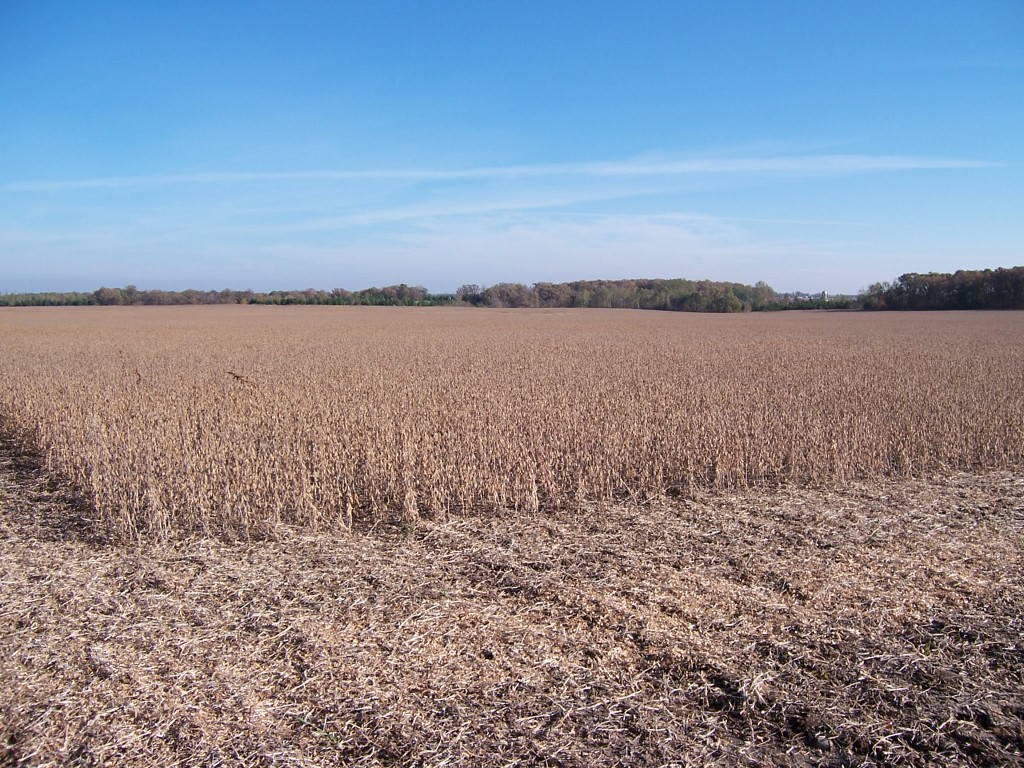
Soybeans offer a preferred and nutritious source of food from germination until the ripe pods are completely eaten. Mature beans like these during late fall and winter are in my opinion the best food plot….if you can plant them.
Cost Effective
I talk a lot about return on investment. With food plots, I look at my investment in money and sweat equity and what those food plots return. With plots like rye, brassicas, or clovers the investment might be an annual cost of $50 to $100/acre, but their return is relatively low if they are competing with soybeans or corn piles. Corn food plots are cost prohibitive for two main reasons, first it can cost upwards of $400/acre in input costs and corn usually requires more initial acreage because small plots get hammered early by deer (when the corn is in velvet), and then by every animal in the woods until it is gone. Soybeans, well, the soybean is relatively easy to grow, has input costs of around $125/acre, and can be planted in exterior plots of 2 acres or more, maybe as little as ½ acre if alongside row crop beans. And the return…as I’ve already stated standing beans during hunting season has more consistent drawing power than any other food plot we have every planted! If you think $125/acre is too much cash, think of it this way—if you spend only $50 but have little or no results you just wasted the $50.
Limitations
OK, so I’ve all but claimed that the bean is the miracle food plot. But there are some limitations.
First, you simply can’t use beans as in interior food plot. Their attractiveness on these small plots in the timber will result in them getting annihilated before they ever mature and form beans with pods. Then once fall comes and they freeze, the green plant is no longer edible and there are no beans left behind. Use green plots for interior food plots.
Second, if you’re planting beans in an area with no agriculture, they can also get browsed off during the spring and summer months resulting in no pods for fall hunting. This can also happen on plots in high deer density areas. I’m often asked how many acres you need to plant a successful bean plot and the answer varies. I’ve planted as little as ½ acre in areas of modest deer densities near ag beans and had them mature and produce pods. In other areas it seems like 2 acres is the minimum. So the one negative of a bean food plot could be available acreage. If you don’t mind an initial one-time input cost you could look into electric deer fencing (Google electric deer fencing) for smaller plots or to “release” soybean plots later in the season so it lasts longer. Soybeans plots will get literally hammered, so if you are planning to hunt them later in the season you must understand that their attractiveness can also be a liability to the hunter and must be planned for.
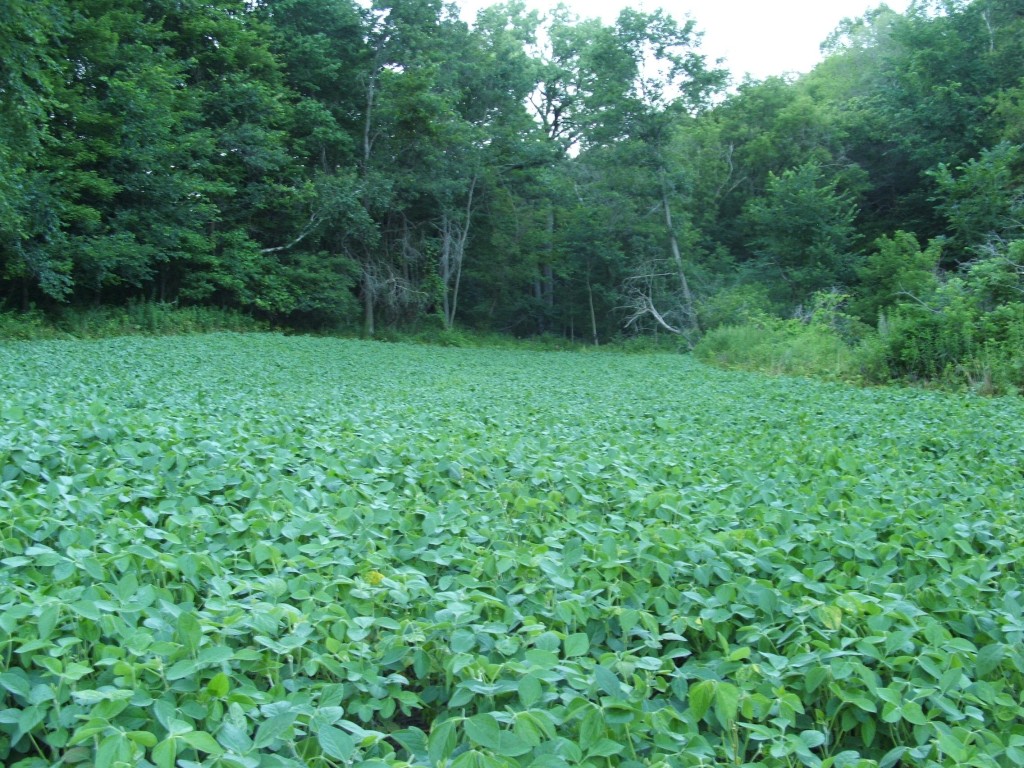
This is one of my soybean plots in mid summer. It is only about a half acre in size but it is surrounded by ag soybeans making it possible for these beans to survive heavy browsing. These beans were planted at a rate of about 140,000 seeds per acre, with 50 lbs of 5-14-42 fertilizer added at planting. These beans are doing great and will get hammered until they are gone once they ripen and the fall harvest removes the ag beans. Get ready to hunt them hard right after the fall harvest.
Planting Techniques
You don’t need a fancy planter to plant soybeans. But, to do this right you do need some equipment. Years ago we planted our beans with a disc pulled behind a 4-wheeler. It worked, but I’m pretty sure we put a beating on our 4-wheelers. They just aren’t made for putting in more than an acre or two. If an acre or two is all you plan on putting in this set up will do.
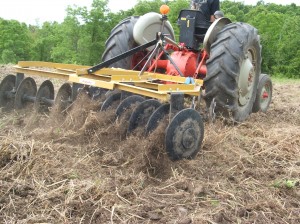
For any plots bigger than an acre or so, using a tractor and disc is the only way to go. I use this Ford 861 and 6.5 foot disc to put in all my beans. I can broadcast in my beans and fertilizer, and disc them in with ease. It takes me about an hour per acre to plant beans on previously planted ground.
Today, I use a small tractor and disc for sowing in the bean seed and a 12 volt atv seeder for fertilizer and seed spreading. I simply put down the seed and fertilizer and disc it in together…nothing fancy and it works just fine. The soybean seed is a relatively big seed so planting depths using a disc shouldn’t be a big concern. Just get the seed in the ground but don’t overdo it. I only use roundup ready seed which is easier for weed control. (Click here for roundup ready information.)
Fertilizer Requirements
Right, wrong, or indifferent I use the replacement method when fertilizing my food plots. It’s a simple concept that says what nutrients and at what rate does this food plot use, and then replace those nutrients when fertilizing. For food plots, it is important to look at the big three of nitrogen, phosphorus, and potassium. Soybean grain removes these nutrients from the soil, so to calculate fertilizer requirements you simply need to figure yield per acre and multiply that by the nutrients removed per bushel. I’ll do it for you….
30 bushel beans remove 126 pounds of nitrogen, 12 pounds of phosphorus, and 38 pounds of potassium per acre. 50 bushel beans remove 210, 20, and 63 respectively. I think it’s fair to say that food plots will yield somewhere between 30 and 50 bushels so fertilizer requirements should fall between these two levels. Soybeans are nutrient scavengers so getting it perfect isn’t critical. AND, soybeans don’t need nitrogen, or very little since they are legumes.
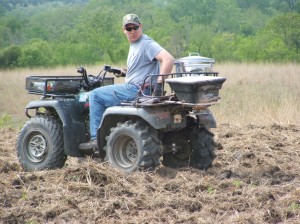
Beans are simply broadcast and sowed in using a disc. Broadcast the beans at a rate of about 200,000 seeds per acre and use the replacement method for fertilizing, also broadcasting the fertilizer.
If you are planting soybeans on ground that hasn’t had soybeans planted in many years you will need to inoculate them. (Ask your seed supplier to help you with this, it’s easy) Since soybeans fix their own nitrogen you only really need to worry about phosphorus and potassium. This is a long version of saying if you put down low nitrogen fertilizer intended for legumes at a rate of one or two bags per acre you’ll do just fine. For years we put down two bags of 17-17-17 per acre without any problems and our beans did great. Soil PH is ideal between 6 and 6.8 but I can honestly say I have never tested for or corrected for soil PH on my soybean food plots.
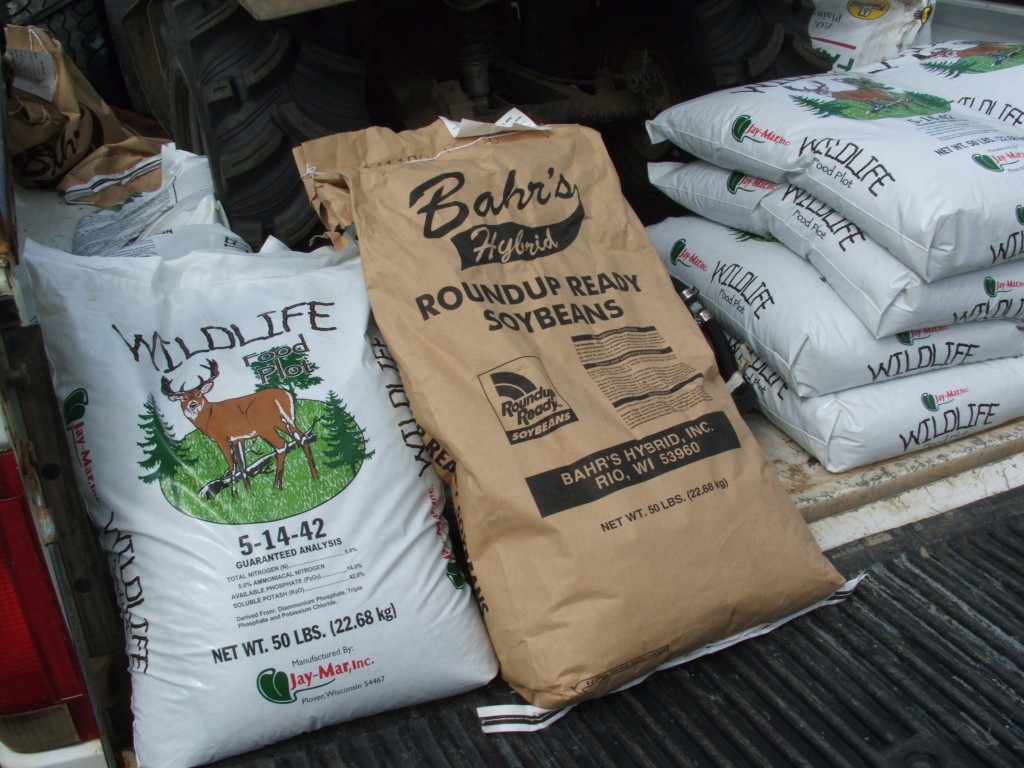
I only use round up ready soybean seeds. This brand is Bahr’s but I have used many others. Typically, seeds are sold in 140,000 seed bags which is perfect for an acre using a planter. I use about 1.5 bags per acre or 210,000 seeds when using a disc to sow them. A bag or two per acre of a low nitrogen fertilizer like the one shown in this picture will get you close to replacing nutrient losses from the bean yield. I spread the fertilizer and bean seeds on the plot and disc them in…that’s all there is to it.
Soybean Seed Maturity
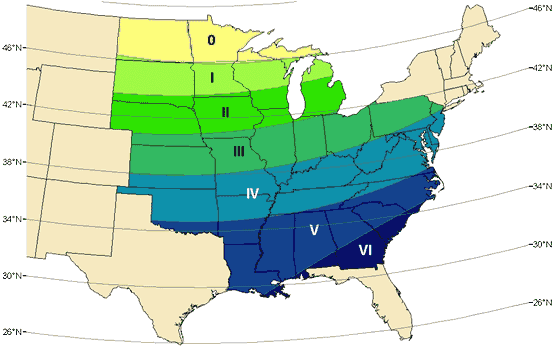
Soybean seed has different maturity categories. This is similar to other seed like 80 day or 95 day corn, only it is expressed in categories. This map shows maturity groups from northern Minnesota all the way to the gulf. When planting beans, use the highest maturity bean you can without going over. In central Wisconsin where I live I will typically plant a late category I bean or early category II. In southern Iowa I can plant a late category II or early III. Later maturing beans will yield better but don’t go with a bean maturity that is too late for your area or you risk losing your crop to early frost and having little to no yield. Planting times vary year to year—if your not sure on dates to plant for your area watch local farmers. I plant my beans anywhere from mid April some years to late May in others.
UPDATE 12/24/14: In 2012 and again in 2013 I had major problems with soybean shatter. Soybean shatter is when the soybean pods get ripe and dry out but then open up (“shatter”) allowing the beans to fall out. It happened at a rate that I lost nearly 50% of my yield available to the deer herd. In 2014 I again had some shatter late in the year going into December. In working with seed manufacturers, we have come to the conclusion that planting a variety of bean that ripens early enough in the fall to harvest is not necessarily the best approach when planting soybeans for deer. Because of this, I will now be planting soybeans at or above the recommended maturity for my area. For example, I will be planting mid category II’s in central Wisconsin and late category III’s to mid category IV’s in southern Iowa. Farmers can’t normally go this route because they need to make sure their beans mature and dry down in time to harvest….harvesting them well before bean shatter. As hunters, we want our beans to last as long as they can—reducing shatter is an important part of this.
In conclusion, I can’t stress enough my belief that soybeans can be the best food plot under the right conditions.
